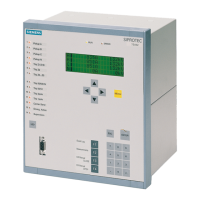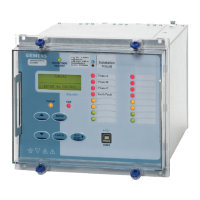7UT51 v3
Motor or Generator Differential Protection (87M/G)
5
PRIM-2330C 71
5.3.2 Nominal Primary Rating
of CTs
Specify the primary rated current for each CT set.
5.3.3 Nominal Secondary Rating
of CTs
The relay is ordered with either 1A or 5A current
inputs. The choice should match the rated nominal
secondary current of the current transformers (CTs)
monitoring the protected transformer. The relay is
shipped with the same rating for all current inputs
(except for the tank leakage current input, if ordered).
A hardware modification can be made to have the
rated currents (1A or 5A) for different current inputs
(see Section 17.9 on page 189). If any current input
will be rated 5A, order the relay with 5A current inputs.
5.4 Trip Characteristic
As shown in Figure 5.3, current transformers (CTs)
measure the currents flowing in and out of the
protected transformer. The relay matches the currents
by taking into account the characteristics of the motor
or generator, as well as the winding ratios of the CTs.
The differential protection function then calculates
(separately for each phase) the “differential current,”
I
diff
:
(5.1)
The differential current,
I
diff
, is a scalar quantity that is
the absolute value of the amplitude of the vector sum
of the fundamental component of each matched
phase-current flowing into the protected motor/
generator. In a system composed of ideal
components, a non-zero differential current is a certain
indication of a fault somewhere within the protected
motor/generator.
As described in Section 5.1 on page 67, the non-ideal
behavior of a real system may result in a differential
current when in fact no fault exists within the protected
transformer. In these cases, the differential protection
must be restrained. To do so, the relay calculates
(separately for each phase) a “restraining current,”
I
rest
:
(5.2)
The restraining current,
I
rest
, is the scalar sum of the
absolute value of the amplitude of the fundamental
component of each matched phase-current flowing
into the protected motor/generator. It is proportional to
the total amount of current flowing through the motor/
generator.
Note that by definition both
I
diff
and
I
rest
are positive
values, and that
I
rest
is always greater than or equal to
I
diff
.
To illustrate the use of the restraining current, consider
three operating situations for a motor/generator:
• During normal operation, or through fault outside
of the protected motor/generator, ,
therefore:
(5.3)
(5.4)
• If there is a short circuit within the protected motor/
generator with equal currents entering from each
side, , so:
(5.5)
(5.6)
• If there is a short circuit within the protected motor/
generator with current entering from only one side,
, so:
(5.7)
(5.8)
Note that for an internal short-circuit fault,
I
diff
= I
rest
.
1207 In CT 1
1208 In CT 2
Rated nominal primary current of the CT on the common
side (Side 1, Address 1207) and the CT on the terminal
side (Side 2, Address 1208) of the motor or generator.
Range: 1
–
100,000 A
Default: 11,000 A
I
diff
=
′
+
′
II
12
I
rest
=
′
+
′
II
12
′
=−
′
II
21
I
diff
=
′
+
′
=
′
−
′
=
II II
12 11
0
I
rest
=
′
+
′
=
′
+−
′
=⋅
′
II I I I
12 1 1 1
2
′
=
′
II
21
I
diff
=
′
+
′
=
′
+
′
=⋅
′
II II I
12 11 1
2
I
rest
=
′
+
′
=
′
+
′
=⋅
′
II II I
12 11 1
2
′
=
I
2
0
I
diff
=
′
+
′
=
′
+=
′
II I I
12 1 1
0
I
rest
=
′
+
′
=
′
+=
′
II I I
12 1 1
0

